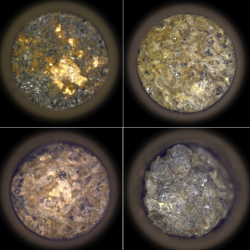
The same general picture of Earth’s interior is taught to school children everywhere: crust on the outside, mantle in the middle, and core at the center. Dig a little deeper, though, and you’ll find that the details of this structure are remarkably mysterious.
Some of the big unknowns are exactly how uniform the mantle is and where and why its properties change. Scientists think that viscosity, or a material’s resistance to flow, varies at different depths within the mantle, with big jumps at 410 and 660 kilometers below Earth’s surface.
Geophysicist Keely O’Farrell at the University of Kentucky and Yuping Wang, her recently graduated master’s student, have now found another major change in viscosity between 1,050 and 1,500 kilometers deep. The researchers will present their findings, which could have far-reaching implications for scientists’ understanding of plate tectonics, on 12 December at AGU’s Annual Meeting 2024 in Washington, D.C.
“It’s really hard to know what the viscosity of the mantle is, and it’s something that’s still quite uncertain.”
“It’s really hard to know what the viscosity of the mantle is, and it’s something that’s still quite uncertain,” said Juliane Dannberg, a geodynamicist at the GEOMAR Helmholtz Centre for Ocean Research Kiel in Germany who was not involved in the study. “It’s one of the least well-constrained parameters” in models of Earth’s interior.
Because scientists cannot dig through the mantle, they rely on indirect methods to peer at it. Some snapshots come from seismic waves radiating from earthquake epicenters around the world. These waves move at different speeds depending on the material they are passing through and bounce off boundaries where material properties change, such as at an increase in viscosity.
Changes in mantle viscosity are often found at depths where other shifts occur. The 660- and 400-kilometer-deep viscosity changes, for instance, go hand in hand with a change in the crystal structure of the minerals present.
O’Farrell and Wang saw in other researchers’ work that rising plumes of magma were “doing something weird” at around 1,000 kilometers deep, so they knew to look in that region, O’Farrell said.
Revealing Viscosity
They began their investigation by pulling together three different models of seismic wave structure in Earth’s interior, hoping to avoid bias and increase resolution by using more than one. They then used a machine learning algorithm to categorize seismic waves into fast- and slow-moving groups at different depths. Separating waves by speed allowed the scientists to see at what depths they would move quickly, representing low-viscosity areas of the mantle, and where they would move slowly, representing high-viscosity areas.
They ran the algorithm on each model, looking for overlap in where wave speeds, and thus velocities, changed. Most of the changes in viscosity were already known. But the analysis picked up slow waves between 1,050 and 1,500 kilometers under Earth’s surface, roughly the driving distance between Washington, D.C., and Chicago. Waves moved slower between these depths than had been assumed previously. O’Farrell and Wang suggested that the mantle’s viscosity is higher throughout that depth range.
“If you want to look at how plate motions were in the past and how they [will be] in the future, then it’s important that we know what the inside of the Earth looked like more accurately.”
Though other scientists had suspected a change in viscosity around this depth under certain parts of Earth, none had suggested it was a global feature. The new study takes that step.
“It was very exciting to actually find something,” O’Farrell said. “It’s a little deeper than I thought, but…it’s consistent with other studies that have now found that there’s something happening at that depth.”
The viscosity jump may be significant for modeling countless aspects of Earth. Most directly, a better awareness of the mantle’s viscosity structure would allow scientists to model past and future tectonic plate locations because plate movement is linked to the slow flow of the mantle.
“If you want to look at how plate motions were in the past and how they [will be] in the future, then it’s important that we know what the inside of the Earth looked like more accurately,” O’Farrell said. The more accurate the model is, the more accurate the predictions will be. That means models of other Earth systems such as volcanoes and climate, which factor in the locations of plates, will also be more accurate.
—Perri Thaler, Science Writer








Leave a Comment